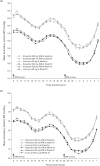Time of administration important? Morning versus evening dosing of valsartan
- PMID: 25259546
- PMCID: PMC4284009
- DOI: 10.1097/HJH.0000000000000397
Time of administration important? Morning versus evening dosing of valsartan
Abstract
Objective: Studies suggest that bedtime dosing of an angiotensin-converting enzyme (ACE)-inhibitor or angiotensin receptor blocker shows a more sustained and consistent 24-h antihypertensive profile, including greater night-time blood pressure (BP) reduction. We compared the antihypertensive effects of morning (a.m.) and evening (p.m.) dosing of valsartan on 24-h BP.
Methods: This 26-week, multicentre, randomized, double-blind study evaluated the efficacy and safety of valsartan 320 mg, dosed a.m. or p.m., versus lisinopril 40 mg (a.m.), a long-acting ACE-inhibitor, in patients with grade 1-2 hypertension and at least one additional cardiovascular risk factor. Patients (n = 1093; BP = 156 ± 11/91 ± 8 mmHg; 62 years, 56% male, 99% white) received (1 : 1 : 1) valsartan 160 mg a.m. or p.m. or lisinopril 20 mg a.m. for 4 weeks, then force-titrated to double the initial dose for 8 weeks. At Week 12, hydrochlorothiazide (HCTZ) 12.5 mg was added for 14 weeks if office BP was more than 140/90 mmHg and/or ambulatory BP more than 130/80 mmHg.
Results: Mean 24-h ambulatory SBP change from baseline to Weeks 12 and 26 was comparable between valsartan a.m. (-10.6 and -13.3 mmHg) and p.m. (-9.8 and -12.3 mmHg) and lisinopril (-10.7 and -13.7 mmHg). There was no benefit of valsartan p.m. versus a.m. on night-time BP, early morning BP and morning BP surge. Evening dosing also did not improve BP lowering in patients requiring add-on HCTZ or in nondippers at baseline. All treatments were well tolerated.
Conclusion: Once-daily dosing of valsartan 320 mg results in equally effective 24-h BP efficacy, regardless of dosing time.
Trial registration: ClinicalTrials.gov Identifier: NCT00241124.
Figures
Comment in
-
Should blood pressure medication be taken in the morning or evening?J Hypertens. 2015 Feb;33(2):263-5. doi: 10.1097/HJH.0000000000000471. J Hypertens. 2015. PMID: 25535879 No abstract available.
-
Comment on 'Time of administration important? Morning versus evening dosing of valsartan'.J Hypertens. 2015 Mar;33(3):663. doi: 10.1097/HJH.0000000000000484. J Hypertens. 2015. PMID: 25629365 No abstract available.
-
Comment on 'Time of administration important? Morning versus evening dosing of valsartan'.J Hypertens. 2015 Mar;33(3):663-4. doi: 10.1097/HJH.0000000000000485. J Hypertens. 2015. PMID: 25629366 No abstract available.
Similar articles
-
Effects of force-titrated valsartan/hydrochlorothiazide versus amlodipine/hydrochlorothiazide on ambulatory blood pressure in patients with stage 2 hypertension: the EVALUATE study.Blood Press Monit. 2009 Jun;14(3):112-20. doi: 10.1097/MBP.0b013e32832a9da7. Blood Press Monit. 2009. PMID: 19384192 Clinical Trial.
-
Tolerability and blood pressure-lowering efficacy of the combination of amlodipine plus valsartan compared with lisinopril plus hydrochlorothiazide in adult patients with stage 2 hypertension.Clin Ther. 2007 Feb;29(2):279-89. doi: 10.1016/j.clinthera.2007.02.003. Clin Ther. 2007. PMID: 17472820 Clinical Trial.
-
Effects of the angiotensin II receptor blockers telmisartan versus valsartan on the circadian variation of blood pressure: impact on the early morning period.Am J Hypertens. 2004 Apr;17(4):347-53. doi: 10.1016/j.amjhyper.2004.02.016. Am J Hypertens. 2004. PMID: 15062889 Clinical Trial.
-
Valsartan: more than a decade of experience.Drugs. 2009;69(17):2393-414. doi: 10.2165/11319460-000000000-00000. Drugs. 2009. PMID: 19911855 Review.
-
Administration-time differences in effects of hypertension medications on ambulatory blood pressure regulation.Chronobiol Int. 2013 Mar;30(1-2):280-314. doi: 10.3109/07420528.2012.709448. Epub 2012 Oct 19. Chronobiol Int. 2013. PMID: 23077971 Review.
Cited by
-
Aging affects circadian clock and metabolism and modulates timing of medication.iScience. 2021 Mar 1;24(4):102245. doi: 10.1016/j.isci.2021.102245. eCollection 2021 Apr 23. iScience. 2021. PMID: 33796837 Free PMC article.
-
Morning blood pressure surge: pathophysiology, clinical relevance and therapeutic aspects.Integr Blood Press Control. 2018 May 24;11:47-56. doi: 10.2147/IBPC.S130277. eCollection 2018. Integr Blood Press Control. 2018. PMID: 29872338 Free PMC article. Review.
-
Chronotherapy for Hypertension.Curr Hypertens Rep. 2018 Sep 28;20(11):97. doi: 10.1007/s11906-018-0897-4. Curr Hypertens Rep. 2018. PMID: 30267334 Free PMC article. Review.
-
New Insights Into Cancer Chronotherapies.Front Pharmacol. 2021 Dec 13;12:741295. doi: 10.3389/fphar.2021.741295. eCollection 2021. Front Pharmacol. 2021. PMID: 34966277 Free PMC article. Review.
-
Characteristics and control of the 24-hour ambulatory blood pressure in patients with metabolic syndrome.J Clin Hypertens (Greenwich). 2021 Mar;23(3):450-456. doi: 10.1111/jch.14229. Epub 2021 Feb 25. J Clin Hypertens (Greenwich). 2021. PMID: 33629806 Free PMC article. Review.
References
-
- Anwar YA, White WB. Chronotherapeutics for cardiovascular disease. Drugs 1998; 55:631–643. - PubMed
-
- Gosse P, Lasserre R, Minifié C, Lemetayer P, Clementy J. Blood pressure surge on rising. J Hypertens 2004; 22:1113–1118. - PubMed
-
- Kario K. Vascular damage in exaggerated morning surge in blood pressure. Hypertension 2007; 49:771–772. - PubMed
-
- Hermida RC, Ayala DE, Fernandez JR, Calvo C. Chronotherapy improves blood pressure control and reverts the nondipper pattern in patients with resistant hypertension. Hypertension 2008; 51:69–76. - PubMed
Publication types
MeSH terms
Substances
Associated data
LinkOut - more resources
Full Text Sources
Medical
Miscellaneous


